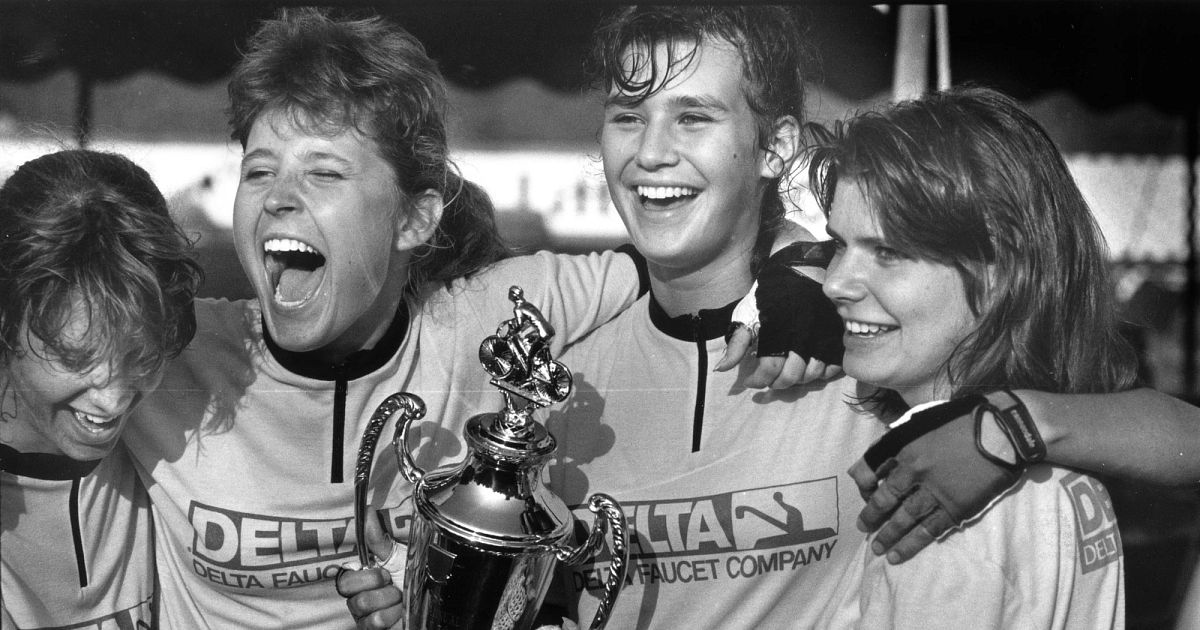 View print quality image
View print quality image
At the end of the first women's Little 500 on April 22, 1988, the team members of Willkie Sprint embraced, celebrating their hard-fought victory. They crossed the finish line first in front of a crowd of more than 15,000 spectators at Bill Armstrong Stadium in Bloomington. Willkie Sprint's victory was a surprise to most race fans.
The team was fueled by their underdog status and a competitive edge. They had trained the entire school year, often cycling to the point of exhaustion. With their full focus on the competition that day, Willkie Sprint had no idea that their race would set the stage for women riding at Indiana University for decades to come.
The team to beat that day was Kappa Alpha Theta, whose members began a grass roots effort to include the women's race in the "World's Greatest College Weekend." If it were not for the efforts of Kappa Alpha Theta teammates Martha Hinkamp, Lee Ann Guzek, and Kathy Cleary, the women's Little 500 may have never happened.
Pioneers of the race
During the 1986-87 school year, Kappa Alpha Theta tried to qualify for the Little 500. At that time, women were allowed to take part in the race if they could qualify. In the end, the Kappa Alpha Theta teammates qualified during the spring series Team Pursuit, but during final qualifications they came in 34th. The race only allowed a roster of 33 teams.
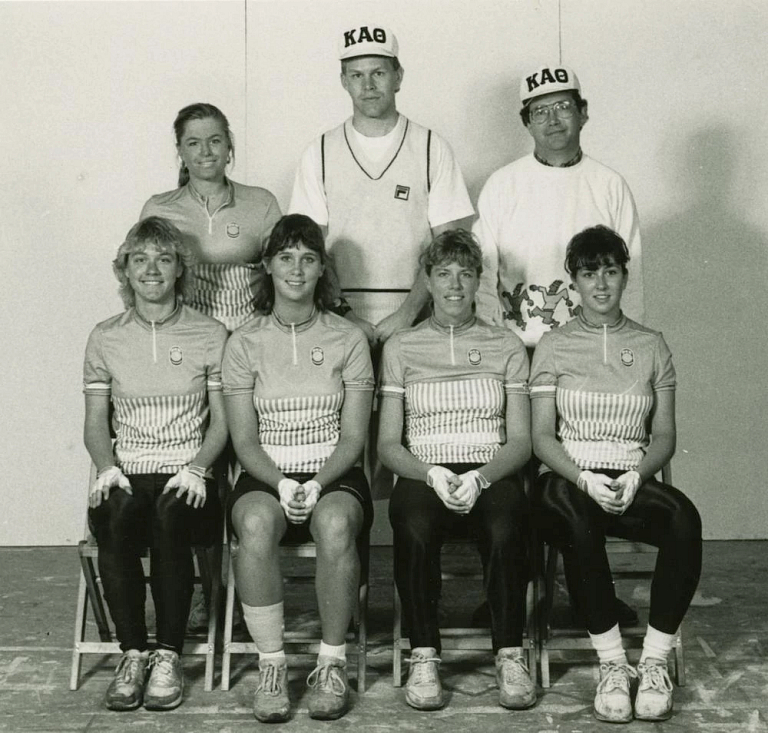 View print quality image
View print quality image
Their result was a common one for women trying out for the Little 500. Other all-female teams had made attempts to qualify in the past, but without a race of their own, women hungry for competition were out of opportunities.
The only other racing option for women was the Mini 500, an indoor tricycle race. The mini was more of a fun event than a competitive sport, although many teams took it seriously. Once men were allowed to participate in the tricycle race in 1978, women no longer had a race of their own that could not be dominated by men.
In the fall of 1987, the riders of Kappa Alpha Theta returned to campus determined to establish a race for women. With support from the university, they worked with Spero Pulos, the 22-year-old assistant director of the IU Student Foundation at that time. Together, they canvassed dormitories, sororities and independent riders across campus. They hosted more than 50 call-out meetings to recruit women to ride.
"I personally went to every single one of them," said Pulos, who was a former rider and coach prior to working for the IU Student Foundation. "We wanted them to know that you can be completely new to this, and you don't need to feel intimidated because it's an attainable task. We're going to be with you every step of the way."
Pulos said he was initially concerned they would not have enough teams sign up for the race, but to his delight more than 30 teams registered. They then set out to ensure those teams were prepared, assigning experienced riders and coaches to assist.
Throughout the process, the Kappa Alpha Theta riders gained press attention. They became the "face of the race." In the meantime, a lesser-known team composed of all freshmen became determined to bring some healthy competition to the track in April.
Breaking bones and breaking away
Being the underdog became motivational fuel for Willkie Sprint teammates Kerry Hellmuth, Kirsten Swanson, Amy Tucker and Louise Elder. Along with their assistant coach, Kristin McArdle, and coach, Kevin Wentz, they set out on a yearlong journey to make it to the top.
"We were the underdog; nobody knew us," said Swanson. "We all came from different backgrounds. I think being the underdog can help elevate you and help you to focus on what the mission and task is without people always hounding you and putting these additional expectations on you. There were no expectations of us other than our own internal expectations."
Just like the Kappa Alpha Theta riders, the Willkie Sprint team had a competitive spirit and grit. Hellmuth grew up in an athletic family in Madison, Wisconsin. She participated in her first triathlon at age 14, and she played soccer, swam and ran throughout high school. Swanson grew up in Greencastle, Indiana, where she competed in volleyball, basketball, softball and running.
They attended the same call-out meeting at Willkie to learn about the new women's race.
"There was a meeting about this thing called the Little 500," said Swanson. "I'd never heard of 'Breaking Away.' Never heard of any of that, but (my boyfriend) loved cycling. It was his passion."
It just so happened that Swanson was dating a rider from the men's race who helped her get her equipment together and train. Hellmuth also found a love story through the race.
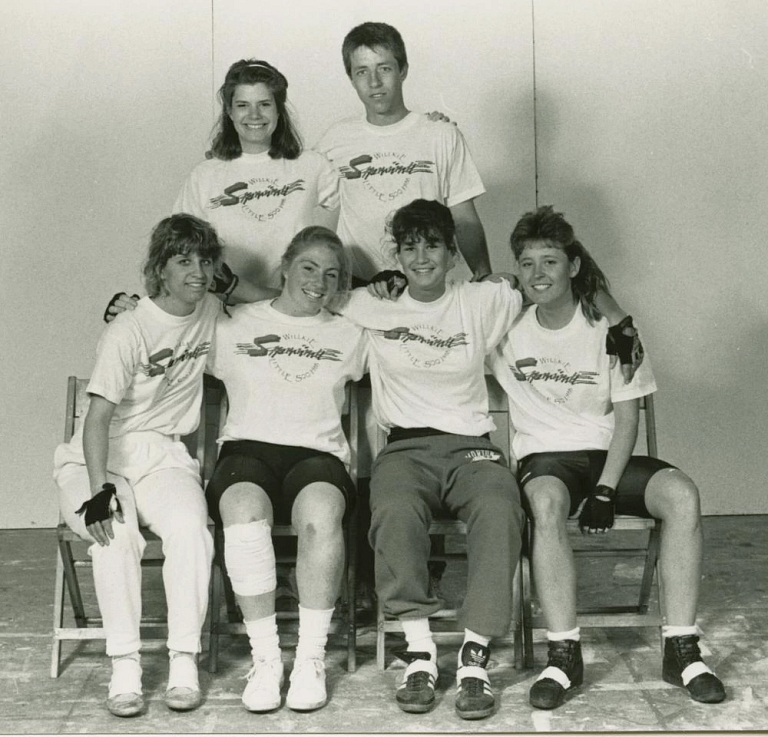 View print quality image
View print quality image
"Personally, I met and fell in love with a member of the guys' team," said Hellmuth. "So that was my biggest supporter and the greatest perk of the whole thing. Bob was on our dorm's men's team, and he always told me that I was the female version of Dave Stohler from 'Breaking Away,' studying Italian and happy as a lark on my bike."
The race was not about romance for the Willkie Sprint riders. It was about competition. They wanted to win, and their training regimen was grueling.
"I can tell you that we were a small group of women that were just so competitive," said Swanson. "Most people wouldn't make it on our team. I mean, if someone wasn't throwing up or crying at the end of the training session, then you didn't work hard enough."
The Little 500 is an amateur competition, but training is rigorous for those who want to win, and injuries can occur. Before race day in April, three riders from other teams broke their collarbones after unsuccessful relay exchanges.
"People were breaking collarbones; you'd have road rash like crazy," said Swanson. "You just had to be fearless."
Willkie Sprint gave up alcohol and sugar during training, and their friends at the dorm made T-shirts that read "No Drinking, No Sugar" to raise funds for the team. Swanson, a kinesiology major who was taking a nutrition course at the time, said she told her instructor that she was feeling run down.
"I had gone vegetarian and quit drinking, and she was like 'I need you go to McDonald's and eat a cheeseburger,'" Swanson said with a chuckle. "I started trying to eat more calories, and I started resting a little bit more. Again, I was going to school full time. I was working 30 hours a week."
Swanson paid her way through college with the job and by joining the military in her freshman year. She said it was a challenge to pay for her first bike, but her boyfriend and the manager of the Schwinn bicycle shop in Bloomington helped her out. Willkie provided the teams with an equipment room to help them train when the weather outside was less than favorable. The riders used rollers, trainers, lifted weights and swam. When the weather was nice, they took advantage of the hilly terrain around Bloomington, often riding out to Lake Lemon.
At the qualifications event in the spring, Willkie Sprint came in eighth place and Kappa Alpha Theta placed first. Hellmuth said Wentz arranged a screening of "Breaking Away" in his apartment at Mason Hall in the Willkie quadrangle. The 1979 film tells the story of the Cutters, an underdog team that beats the odds and wins the Little 500.
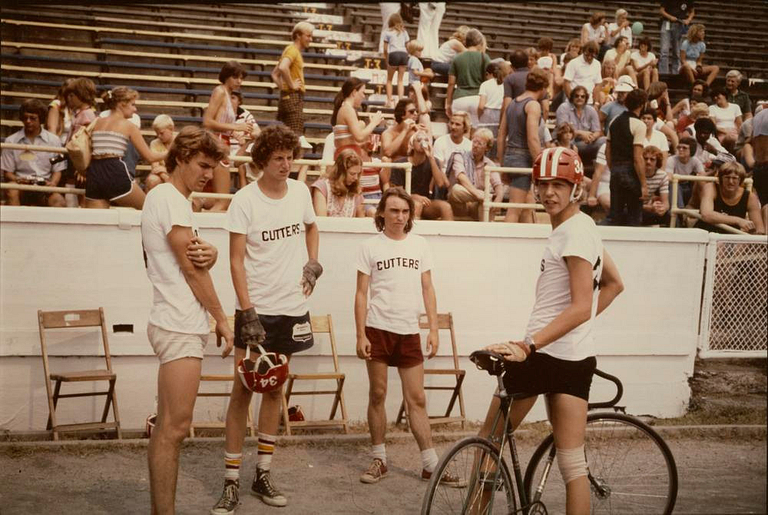 View print quality image
View print quality image
"Watching 'Breaking Away' together was great for us," said Hellmuth. "We dared to dream of doing the same thing ourselves -- a ragtag band of scrappy newcomers taking down the legendary creators of the race. For all of us, and especially an all-freshmen team like ours, the Thetas seemed to own the race. Kevin had been timing their splits as well as ours, and he made sure to tell us that night that we could beat them. I remember him telling us 'Don't be afraid to win.'"
"He probably was thinking what everyone was thinking -- the Thetas were expected to win this race because they were the only ones who had experience from trying to qualify for the men's race the previous year. They were the ones who had fought to make the women's Little 500 a reality. We all looked up to the Thetas, and they sort of owned the race. Kevin was telling us to give ourselves permission to beat them, to become the first winners of the women's Little 500 ourselves. I think we had a somber and steely resolve to try to do just that the next day."
A crowd, a crash and the final stretch
The day of the race arrived. Friends from the dorm cheered on Willkie Sprint from the stands. Hellmuth recalled that her dad and sister drove down from Wisconsin to support her.
Hellmuth said she and her teammates were amazed by the sheer number of spectators. The stadium was abuzz with students loudly cheering on the women. The weather was beautiful -- blue skies and sunshine. Willkie Sprint set up trainers in their pit area and warmed up before the festivities began.
Phyllis Klotman, the dean for Women's Affairs, addressed the crowd. She was instrumental in getting the women's race started, along with the Theta riders. Hellmuth remembers Klotman taking a celebratory ride around the track on one of the tricycles from the Mini 500 before the race began.
"She was probably in her 60s and tiny," said Hellmuth. "She took a lap around the track on one of the oversized tricycles, heralding the end of the era where women did not have the right to compete."
Swanson said their strategy on race day was to try to lap the field, a method that would add protection if there were any accidents. They followed the strategy that their coach laid out for them.
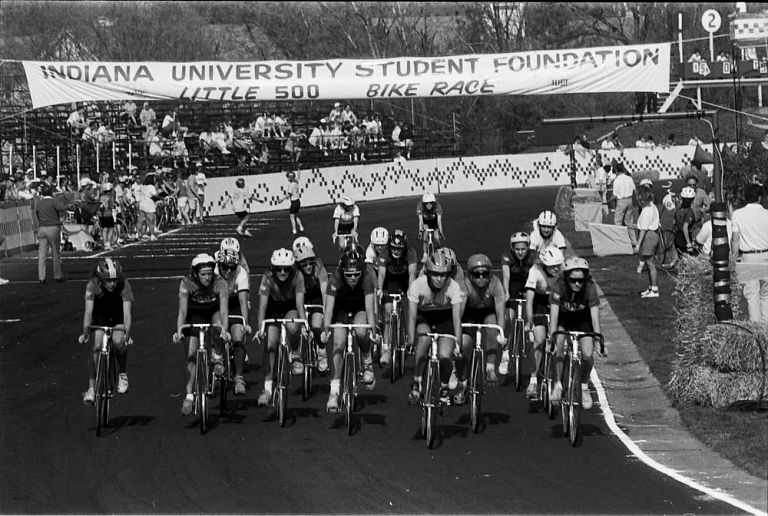 View print quality image
View print quality image
"I was on the bike early and ended up avoiding a crash in the first 20 laps of the race, and the mayhem that followed helped us get our lead," said Hellmuth. "Once we had it, we exchanged as little as possible to keep ahead. We maintained a lead of between 10 and 20 seconds for most of the race. The Thetas, Alpha Phi, and the Notorious team kept making attempts to catch us and would gain on us for a while, and then we'd fight back. Most of the race was a nerve-wracking cycle like that."
"I could hear that first crash happening all around me and high-tailed it out of there. In my own pulls after that, I just rode with all my might and focused entirely on avoiding other potential crash situations."
That was not the only crash on the track that day. Near the end of the race with roughly 10 laps to go, it was time for an exchange, with Hellmuth going out and Tucker going in. Tucker said she was having leg cramps, so Swanson went back in instead. The women's race consists of 100 laps, and on lap 97 there was an accident. The yellow flag came out, which indicates to riders that they must slow down and maintain their positions. It is illegal to try to attempt an advance and could result in penalties, so Swanson slowed down.
 View print quality image
View print quality image
"The drama in the final few laps was that when the yellow flag came out, Kirsten slowed down, and the Theta rider, LeeAnn Guzek, started to gain on her under the yellow," said Hellmuth. "We were all sort of freaking out since it seemed our hard-achieved advantage was just disappearing with the end of the reach and victory at our fingertips."
Swanson remembers those last few laps well.
"The referees are telling me to slow down," said Swanson. "Kevin's telling me to speed up because the field behind me was starting to catch me, so we went from being three quarters of a lap ahead to them basically getting almost a quarter of a lap behind me. We see the green flag come back out, and we have like two laps left. I freaking take off. I go as hard as I can for the last few laps, and I cross the finish line first."
Willkie Sprint won 9 seconds ahead of the Thetas. The team was on cloud nine. They were immediately rushed by infield photographers and reporters.
Then and now
"After race day, my dad told me, 'Hon, you didn't tell me what a big deal this was,'" said Hellmuth. "I don't think the full significance of what we had done hit me until we won. I had heard the story of how women had fought to get this race going, and I knew the story of the Thetas from the year before, but the true magnitude of the historical advance, in light of what it meant for women to finally have their own race, I become more cognizant of that later."
Swanson remembers Hellmuth went to the Thetas and embraced them.
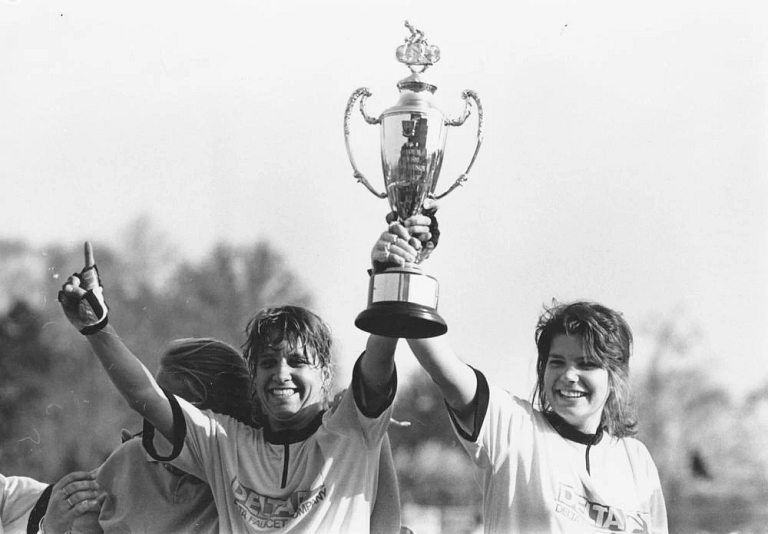 View print quality image
View print quality image
"Kerry went straight over to Leeann and Martha and hugged them," said Swanson. "We all hugged it out because, in reality, this is a big deal. It didn't matter really who won, but we started the first one, and the goal is for it to continue."
Steve Tesich, who wrote the Academy Award-winning screenplay for "Breaking Away," called the Willkie Sprint riders at their dorm to congratulate them after their 1988 win. They each had the opportunity to speak with him. Hellmuth remembers he asked her what actor she thought could play her in a film if they made a movie about the women''s race.
Tesich was inspired to write "Breaking Away" after his experience as an alternate rider for the victorious Phi Kappa Psi Little 500 team in 1962. He based the main character in the film, Dave Stohler, on his teammate, Dave Blase, who rode 139 of the race's 200 laps. According to Tesich, Blase and the character based on him in the film both developed a passion for all things Italian, including Italian cycling.
Hellmuth found inspiration in the film's main character. After graduating with an English degree from IU, she earned a law degree in her home state of Wisconsin and later became a professional cyclist. She competed in the Tour de France, the Giro d'Italia (Tour of Italy) and women's World Cup races. Hellmuth currently lives in Trento, Italy, with her family and teaches at the University of Trento law school.
"Cycling is a big sport here, and we live in an area of the Dolomite mountains with amazing riding," said Hellmuth. "My favorite side activity is with Cinghiale Cycling tours run by Giro d'Italia winner, Andy Hampsten, and his wife, Elaine, helping them guide mostly-American clients as they experience the joys of cycling, eating, and drinking their way through some of my favorite parts of Italy."
Hellmuth said she can hear Mendelssohn's Symphony Number 4, also known as the "Italian Symphony," in her head while she cycles the hills of Italy. No headphones or ear buds -- just her mental recreation of the inspirational music from "Breaking Away."
"I guess I do have a little bit of Dave Stohler in me -- his love of being on two wheels and his appreciation of Italy," said Hellmuth.
Swanson moved to Colorado after graduation. She recently retired from a decades-long career serving in the army where she earned the rank of Colonel. She currently lives in Texas.
"I've jumped out of airplanes," said Swanson. "I was deployed twice to Afghanistan and Iraq, went to (Hurricane) Katrina. You know when the Super Bowl goes on? There is always a team somewhere near where the event is going on that is ready to respond in case of a major "bad" event. I did that for almost two years."
"The race has been a huge influence in my life. That opportunity taught us a lot of skills whether we knew it or not -- how to work with one another, how to work off each other's strengths, how to overcome challenges. For me in the military, that was extremely valuable."
Swanson said she was inspired to compete in triathlons by Hellmuth, and she currently enjoys riding her Peloton.
"Cycling was an outlet for me. You don't have to be male or female, right? You just get on the road and go cycling, and you try to solve the world's problems."
The 34th women's Little 500 recently took place, and Hellmuth and her son watched the live broadcast from her home in Italy.
Melanzana, considered an underdog team, won in a landslide by lapping the field twice. The breakout star of the race was Bloomington native Grace Williams, who won the individual time trials before race day. She said she feels a responsibility to honor the women who blazed a trail for today's riders.
"We were all holding hands and walking around the track before the race," Williams said. "I had no idea we were going to do what we did, but I had tears rolling down my cheeks because I was like 'Wow, I get to be a part of this.' No matter what happens, that's all that we need."
 View print quality image
View print quality image
May 04, 2022 at 10:41PM
https://news.iu.edu/stories/2022/05/iub/28-first-womens-little-500-willkie-sprint.html
Underdog victors of first women's Little 500 reflect on 1988 race - IU Newsroom
https://news.google.com/search?q=little&hl=en-US&gl=US&ceid=US:en

No comments:
Post a Comment